
Two weeks in Tamil Nadu and Karnataka, both southern India, all organised by our good friend Jane Points, whose business Points South specialises in that part of the world.
I must give a warning. Tamil Nadu has many temples: which are what you go to see and admire. But people talk about getting “templed-out”. And that is possible: they do have their similarities. So, my warning is that I will be describing the ones we saw, not in guide-book detail, but enough frankly to enable me to have some memory of them. This journal is partly an aide memoire. What I will try to do is alert the reader to temple commentary. Please skip according to taste.
We went over Christmas and New Year. Southern India can be hot, but at this time of year it’s not, certainly by Indian standards. I don’t think the thermometer ever got above 30 Celsius and it was normally coolish in the evening. Where we were in Karnatika, which is some 1,000 meters above sea level, even a jumper could be a useful piece of kit.
Wednesday 19 December
We arrived in Chennai (Madras in days gone by), late in the evening after our usual stopover in Dubai, thus avoiding a night flight and allowing a night in the comfort of the Millenium Airport Hotel, Dubai.
We were met at the airport by Bennet, our driver for the next few days (with Mary, below). He is well known to Jane and comes from Companion Holidays, the local travel firm that Jane uses. Companion do a good job, based in Trivandrum way down towards the southern tip of India and run by a Mr Daniel who everyone refers to simply as Daniel.
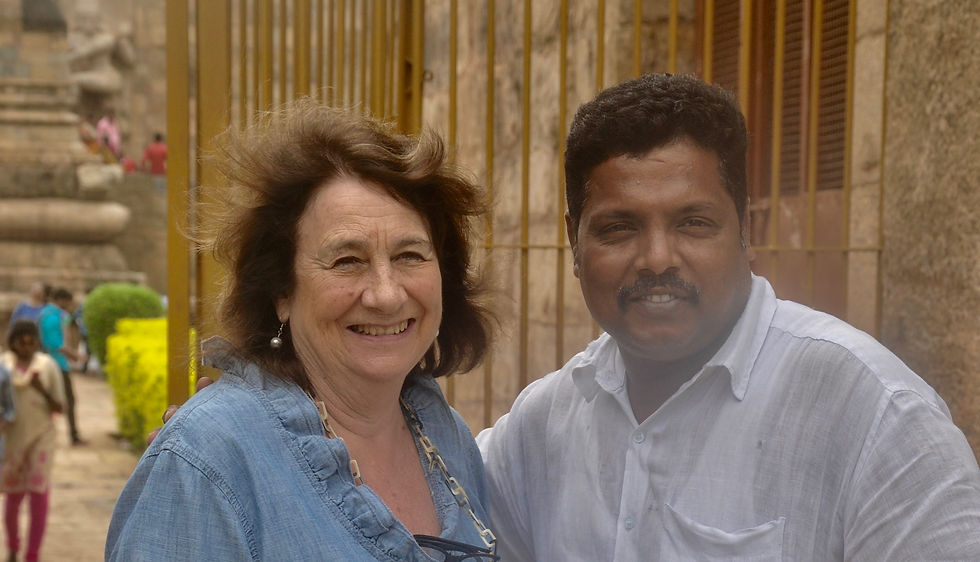
Bennet also comes from faraway Trivandrum and was our valued and charming friend for all our time in Tamil Nadu till he delivered us to the airport to go to Karnatika. All he did when we met him was deliver us to an airport hotel (the Trident, part of the Oberoi group, and very comfortable) to prepare for our drive the next day. We didn’t see anything of Chennai. Maybe there’s not much to see, although one could, I suppose, explore the site of Clive’s victories over the French – which were one of the main reasons we now speak English in India.
Thursday 20 December
Speaking of the French, our next night was in Pondicherry, where the French remained until shortly after Independence.
Bennet drove us there in his minibus. The vehicle seats at least 16 people, so we rattled around in it.
On the way we stopped to see our first temple – Mamallapuram. There are several, all (or most) carved out of single granite rocks, bordering the sea. We were shown round by a very expert guide, Gopal. The system with Companion is that the driver is driver plus guide, except where you need more high-powered guiding, such as in some of the temples. Gopal explained the features of these temples well.
They date from around 600 AD, well before we had got round to building our cathedrals, and before they had the benefit of metal cutting tools able to cut their way into granite. Gopal described how they cut into the rock by inserting wood and allowing it to moisten and expand. I’m not sure I quite understood the detail. But the temples are astonishing and beautiful – quite unlike anything we saw elsewhere – and remarkable for having survived the battering of weather, waves and tsunamis over the many centuries.
There are three types of temple. The most impressive is a group of three temples, all carved out of one gigantic chunk of rock. Another is the Shore Temple built out of pieces of rock. The third type is relief carving on the face of the rock.
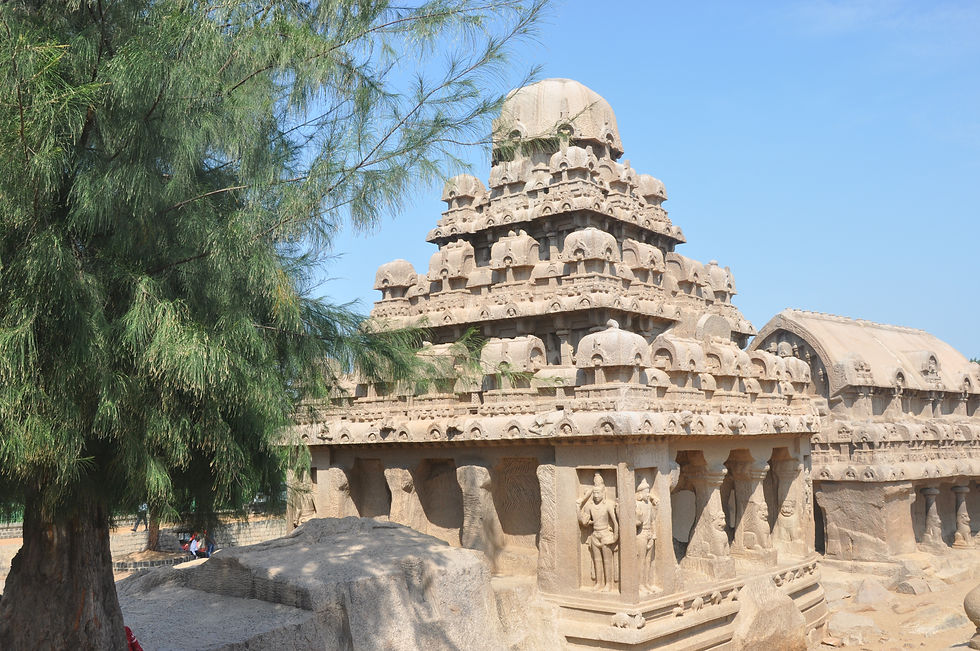
Mamallapuram is also a good place to stop for lunch. Jane says that Rick Stein’s favourite Indian restaurant is there. I’m not sure which it is, but we had a good lunch at a nice restaurant, sort of overlooking the sea.
Incidentally, the place is also called Mahabalipuram or, apparently, Mahabs for short. There’s this slightly confusing tendency to rename places, sometimes doubtless to get away from colonial overtones: hence Madras to Chennai. But often the old name still surfaces, possibly because the real names are such tongue-twisters. A good example is the hill station (which sadly we didn’t have time for) that used to be Ootacamund and is now Udhagamandalam – but is understandably always called, even on signposts, Ooty.
On to Pondicherry – again, now Puducherry but often called Pondy. We arrived in mid-afternoon, in time only for a short stroll around to orientate ourselves. It is, of course, one of the few relics in India of French settlement. The French remained there throughout most of the British years and only left in 1954 shortly after Indian independence. Famously the French influence survives in the delightful tranquil atmosphere of its tree-lined streets, particularly in the so-called French Quarter. This is located between the seafront and a canal that divides it from the Tamil Quarter. Actually the Tamil Quarter is also attractive; and, I have to say, the pavements in the French Quarter need urgent attention.
Our hotel, the Palais de Mahé, is right in the French Quarter and is small and delightful. The manager admitted that it isn’t old. It was built as a reproduction “colonial-style” mansion, not grand, with spacious rooms around three sides of a rectangular swimming pool. It reminded us of the “gentilhommerie” we used to stay at in Brantome. Unfortunately, at the moment building work is going on the fourth side of the rectangle, shielded from us by a large blue tarpaulin screen. I understood that the new building will include an extension to the hotel. It’ll be nice to get rid of the tarpaulin.
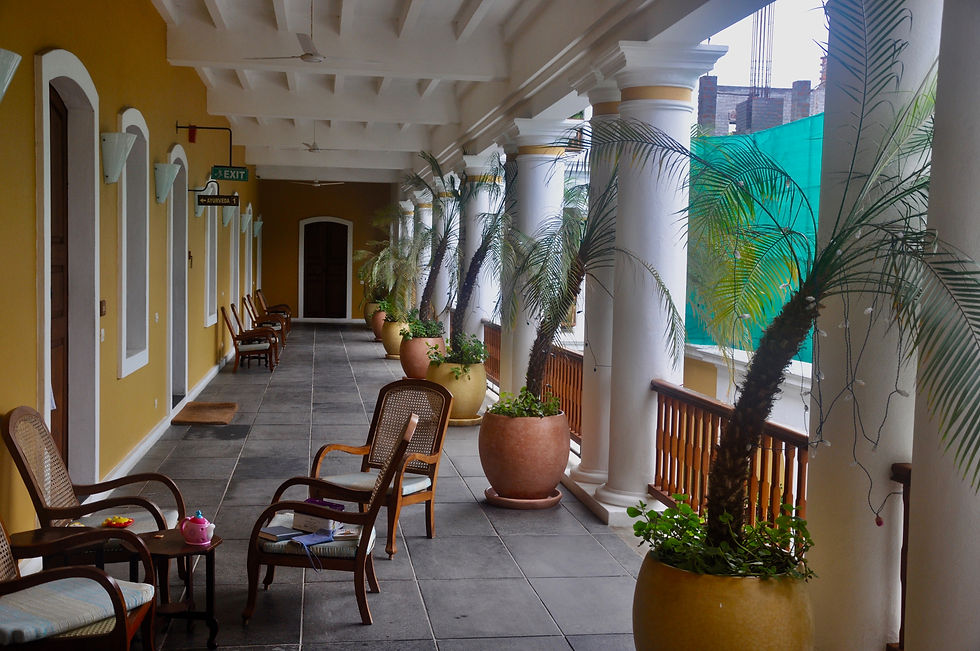
We made friends with a charming American couple from Austen, Texas – Cal and Virginia Holman. He had been on business in Delhi and they were coming to the end of a tour of southern India.
Friday 21 December
This was the first of two days in Pondicherry. We went to a temple dedicated to Ganesh the elephant god, a wonderful veg and flower market, and a rather gaudily decorated Catholic church, but the most interesting thing was an ashram. It was established by a guru called Sri Aurobindo, who was originally from Gujerat, and a French-born lady, who is referred to as “the Mother”. It is a silent place where people come to meditate. But it has also established various businesses, including a papermaking business that we looked around. You see the craftsmen “marbling” the paper, by dunking it into a liquid, drawing seemingly random patterns onto the liquid and then pulling out the astonishingly intricate and beautifully marbled paper. The paper is made from a mixture of all sorts of old cloths and vegetation.
The ashram also owns the building site adjacent to our hotel and is currently doing the rebuilding work behind the blue tarpaulin. Where does its money come from? Donations, we were told. We contributed an embarrassingly modest amount by buying a very reasonably priced notebook and a book about the spiritual teaching of the great man - which I have yet to read.
In the afternoon we took a rickshaw ride, feeling sorry for Cally the driver as he pedalled along, but it’s a good way of seeing the place. It’s also interesting to see how the traffic system works. There are no traffic lights and no discernable distinction between a main road and a side street. Our rickshaw man simply cycled out into the traffic. How alarming! But the other vehicles simply manoeuvered around him. There is a clear hierarchy: motor cars and buses avoid tuktuks; tuktuks avoid rickshaws, and all of the above avoid pedestrians and cows.
Saturday 22 December
Sadly on our second day in Pondicherry we were confronted with low cloud and
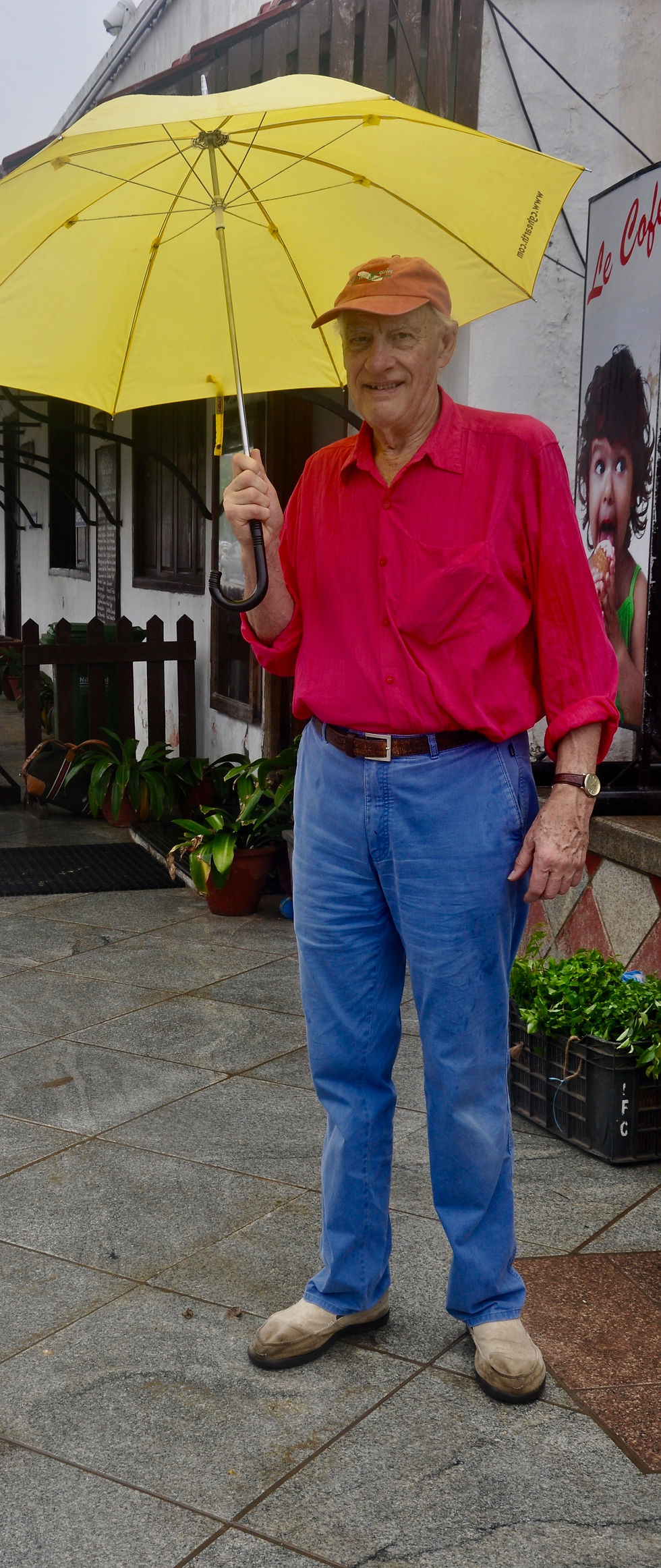
intermittent rain. Armed with bright yellow umbrellas, we bravely marched round to the Pondy museum. Probably busier than usual, partly as it’s Saturday in a holiday period and partly the rain.
It was unexpectedly interesting: somewhat dilapidated relics of French furniture, but also the remains of ancient Roman and Greek amphorae. There was an Iron Age settlement just down the coast some 2,000 years ago, which was a trading centre importing wine, olive oil, and the curious fish sauce, Garum, that the Romans were partial to. We owe our knowledge of these things to the work of French archaeologists in the 1930s.
We had dinner with our new American friends at the Villa Shanti, an attractive restaurant with its out-door terrace. Good food, extensive menu, including French dishes, but slow service.
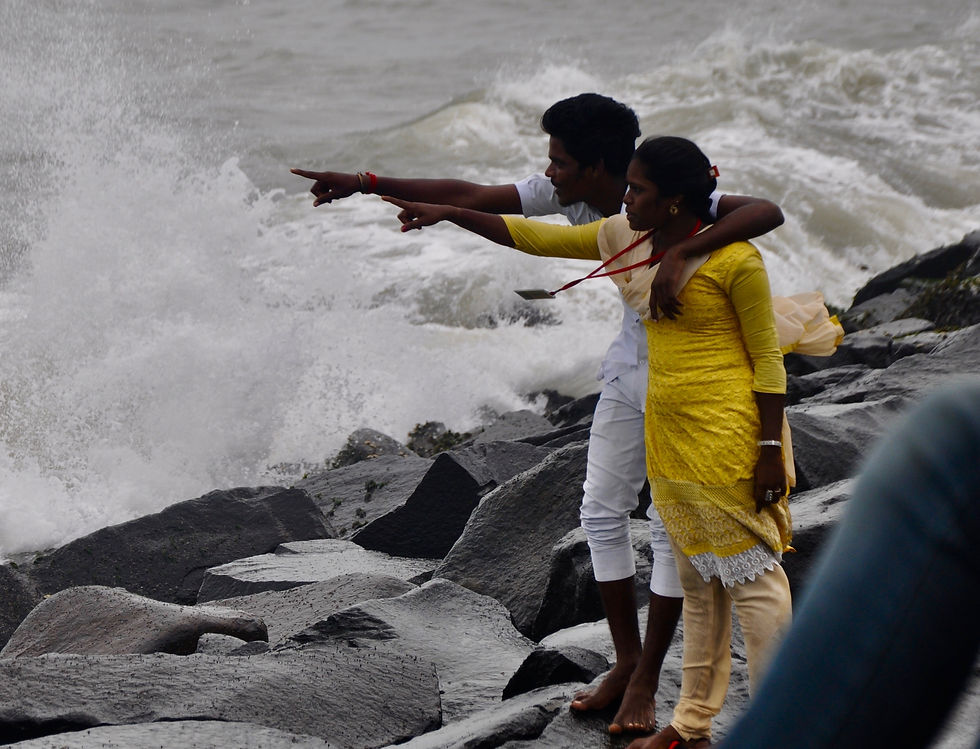
My impressions of Pondicherry were rather spoilt by the weather. The seafront with its elegant buildings must be wonderful, but with the blustery wind and impressive waves breaking onto the granite rocks, it seemed more reminiscent of a nasty holiday weekend in Clacton than the sun-baked Coromandel Coast.
Sunday 23 December
On to the next place, namely Kumbakonam, a city of temples, but on the way we take in two major temples, very different from each other, and both with quite unmemorable names, at least to the non-Tamil speaking foreigner.
The first was at Chidambaram. The temple, which is really a vast collection of temples called Nataraja, is dedicated to the Lord Shiva. It happened to be a special festival day, attracting crowds of some 300,000 - not including us. As it had rained overnight, there was a lot of mud around, so taking off your shoes as is the custom, and padding around in bare feet, was a challenge.

This was an occasion where we had a guide. He, Anand, appeared miraculously just as we arrived. We and Bennet had some debate about how tall Anand was. We thought about 4 foot, but Bennet said no, closer to 3ft 6in. Not a big man, but an enthusiastic guide through the seething masses.
It is one of the holiest of the Shiva temples, hence the crowds. Shiva, one is told, won a dance competition – Nataraja means Lord of the Dance – and there are many images of Shiva in dancing mode. The temple complex has several Gopurams, the great conical towers that Tamil Nadu is famous for. On these towers are the multitudinous carvings, each painted (literally) in all the colours of the rainbow (see the photograph of assorted naked ladies, right at the beginning, above). Frankly, it makes them seem garish to our western eyes, used as we are to unpainted churches and cathedrals. But then you have to remember that our cathedrals originally had painted statuary, as did the Greek temples. The gopurams of the Nataraja temple go back to at least the 11th century, with the shrines being even earlier.
The second temple we saw on the way was quite different as it was constructed of unpainted natural stone, and so, to us, seemed more beautiful. It has a seriously difficult name, Gangaikondacholapuram, but it means City of the Chola who conquered the Ganges, the Chola being the people who ruled in the 10/11th centuries. Also dedicated to Shiva (the destroyer of evil and creator of good, I think), so the temple has a massive statue of a bull (a Nandi) as well as the holy phalluses (lingams) both of which get associated with Shiva.
Our resting place for two nights, just outside Kumbakonam, was called Mantra Koodam. It is one of the most tranquil places imaginable, run by the same group, CGH, that runs the Palais de Mahé in Pondicherry. CGH stands for Clean Green and Healthy, which gives you an idea of where they come from. It consists of about 30 rooms, each in its own bungalow, surrounded by a forest of trees, home to multitudes of voluble parakeets – even more than in Eel Brook Common.
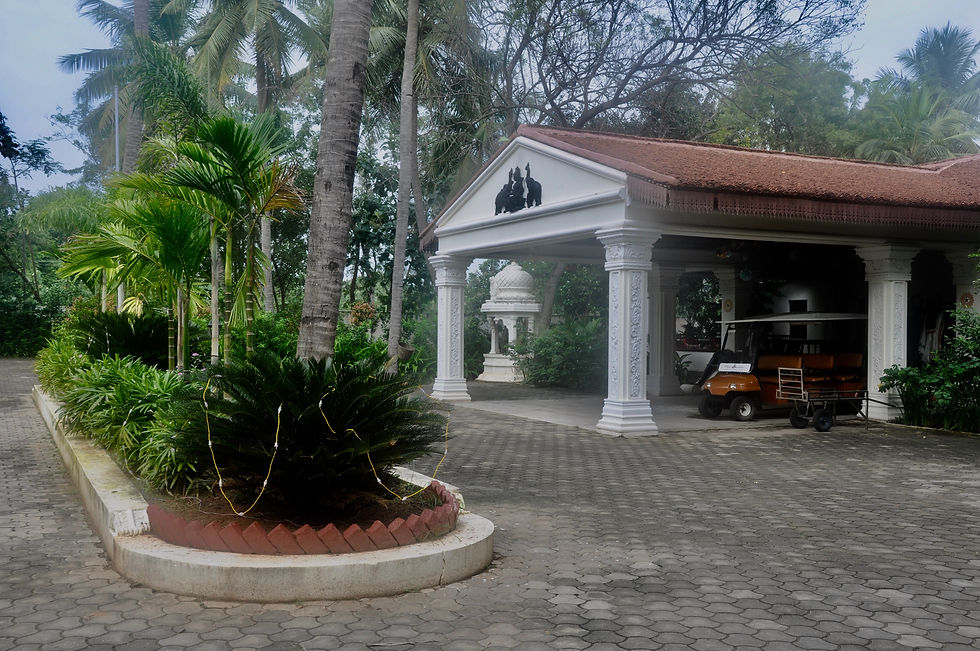
The shower room is a “wet room”, with its cold shower open to the elements. It had rained before we got there, so the wet room was living up to its name more than usually for this time of year.
A curiosity of these splendid spacious rooms (and I’ve noticed it elsewhere in up-market India) is an almost complete lack of cupboards. One’s fellow tourists tend to arrive with large suitcases, much larger than ours. Where do they put it all? We all live out of our suitcases.
Monday 24 December
Kumbakonam is a town of temples, over 100 of them, mercifully not all on our list. I’m going to give the basic details of the four we did visit, partly for the record and partly because it may be of interest to anyone planning a similar trip. But I would forgive anyone skipping the detail.
The first was Sarangapani Temple. It is dedicated to Vishnu, the protector. You enter through a multi-coloured gopuram, with reliefs depicting the god’s imaginative sex life.
The next was Nageshwara, this time dedicated to Shiva, the oldest in town dating back to the 9th century, built in unpainted stone.
Then there was the Mahamaham Tank, some 200 meters square, full of water, fed by various wells, surrounded by 17 coloured pavilions – one of the most sacred sites.
And finally the Airavatesvara Temple in the nearby village of Darasuram. Here we had, with some difficulty, to climb down into the temple to admire the various carvings of Shiva and his attendant elephants, horses and other animals. Again, unpainted.
Enough of the detail.
It is fun to take photos of the people, both in the streets and going into the temples. Normally there seems to be no difficulty, although obviously it’s best to ask first. In many cases the answer is enthusiastic acceptance, particularly with children and youngsters.
Bennet took us to what he described as a Brahmin village where most of the inhabitants are of that priestly (upper class) caste. It was interesting: very clean, very orderly, not many people around, by no means lavish but the occasional high quality car carefully parked outside the apparently modest house. Going back to the subject of photos, we came across a group of young boys playing a ball game. They were hugely excited to be photographed. One of them understood enough English to be able to translate our answers to their questions (Where are you from? Why do you come to India? Etc). It’s nice to find people as interested, and amused, in observing us as we are of them.
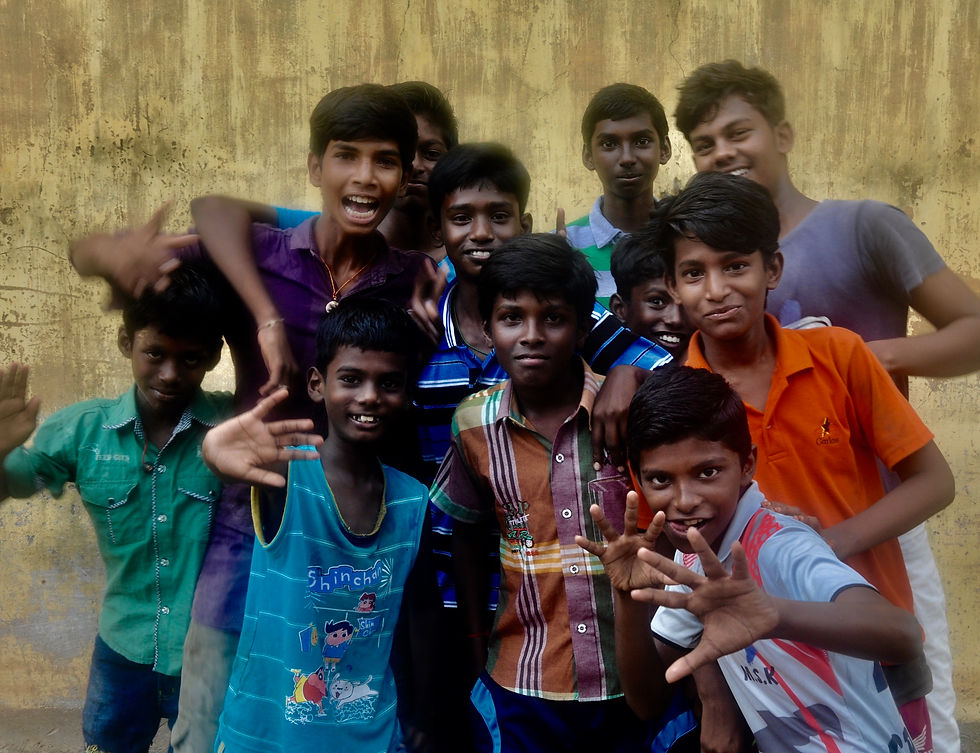
As already indicated, the Mantra Koodam is one of the many hotels run by the CGH group. It was taken over from the previous management only about a year ago. Service excellent, food good, alcohol limited to beer which we seemed to be running them out of – no more Kingfisher, down to another brand pleasantly named “British Empire” – extra strong.
You don’t escape Christmas in Tamil Nadu. It was Christmas Eve of course. Before dinner all the staff paraded round the grounds dressed as Santa Claus and his acolytes, beating drums and singing Jingle Bells. We were given a clutch of toffees and some balloons by Santa himself. There was even roast turkey in the buffet.
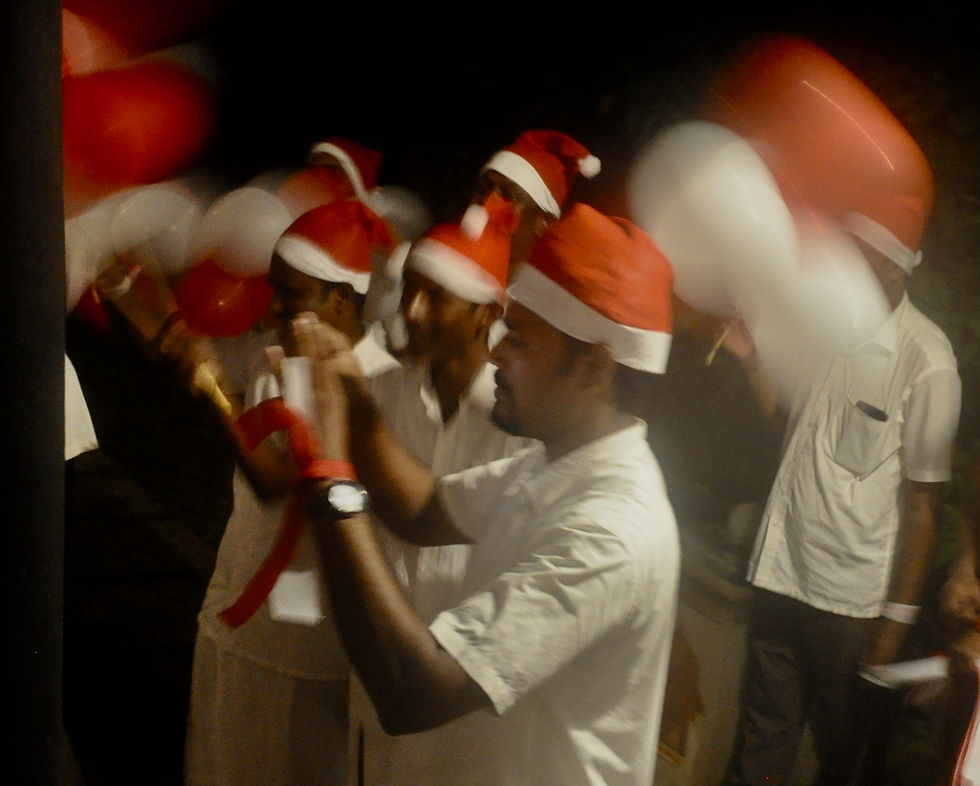
Tuesday, Christmas day
On to Tanjore, location of the great temple of Brihadishwara, and then onto Chettinad, home of the Chettiars.
The temple is the high point of the temple visiting, so it was good that the weather was showing distinct signs of improvement. We had been seeing a lot of cloud (not so good for photography); now hazy sunshine was breaking through.
We were met outside the temple by our guide, this time a lady, Mali. She was pleasant and knowledgeable, but not enthusiastic. She gave the impression of having guided a few too many bored tourists. (I almost wrote bored foreigners, but actually almost all the tourists we saw, throughout our travels, were Indians.)
The temple is certainly the most impressive of all the ones we saw, and is a World Heritage site. The crowning glory of Chola temple architecture, the guidebook says. Definitely.

It consists of several towers but principally one very tall (69 meters) gopuram, constructed in granite with a pale terra-cotta covering – much more attractive to our eyes than the painted ones.
Mali explained how they think it was constructed, back in the 10th century, by hoisting granite blocks up ramps in ways reminiscent of how they reckon the pyramids were built. She also explained why some temples are painted and others, like this one, were not. She said that it’s simply the granite ones are not because you can’t paint granite. The painted ones are covered with a form of stucco, which you can.
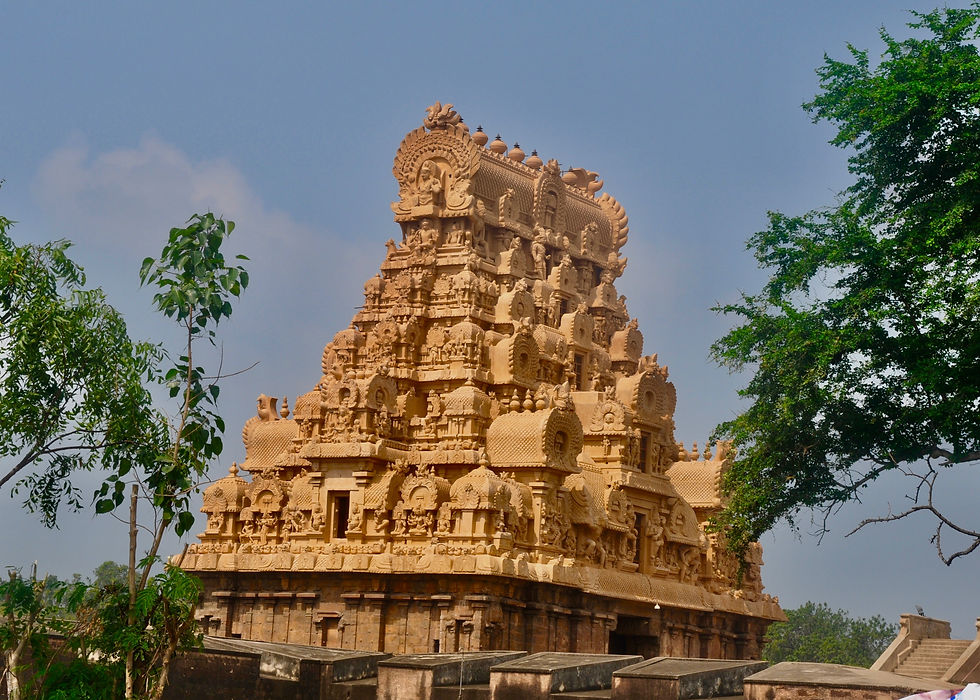
It is dedicated to Shiva, so the central shrine (which we didn’t go into –I’m not sure if you can) contains the most gigantic lingam. And outside the main gopuram is a massive statue of Shiva’s sacred bull, the Nandi – the second biggest in India (apparently there’s another bigger one in Andhra Pradesh). It is carved from a single rock.
After the temple (and the museum of ancient bronzes) we went to see a tiny bronze works, where a craftsman was demonstrating very clearly how the “lost wax” method of casting a bronze statue works. He showed us his model in a mixture of beeswax and resin; how he surrounded it with a mould; baked it; got rid of the wax/resin; then poured in the metal. It would have been nice to buy one of his small statues, but frankly, what does one do with a statue of Ganesh?
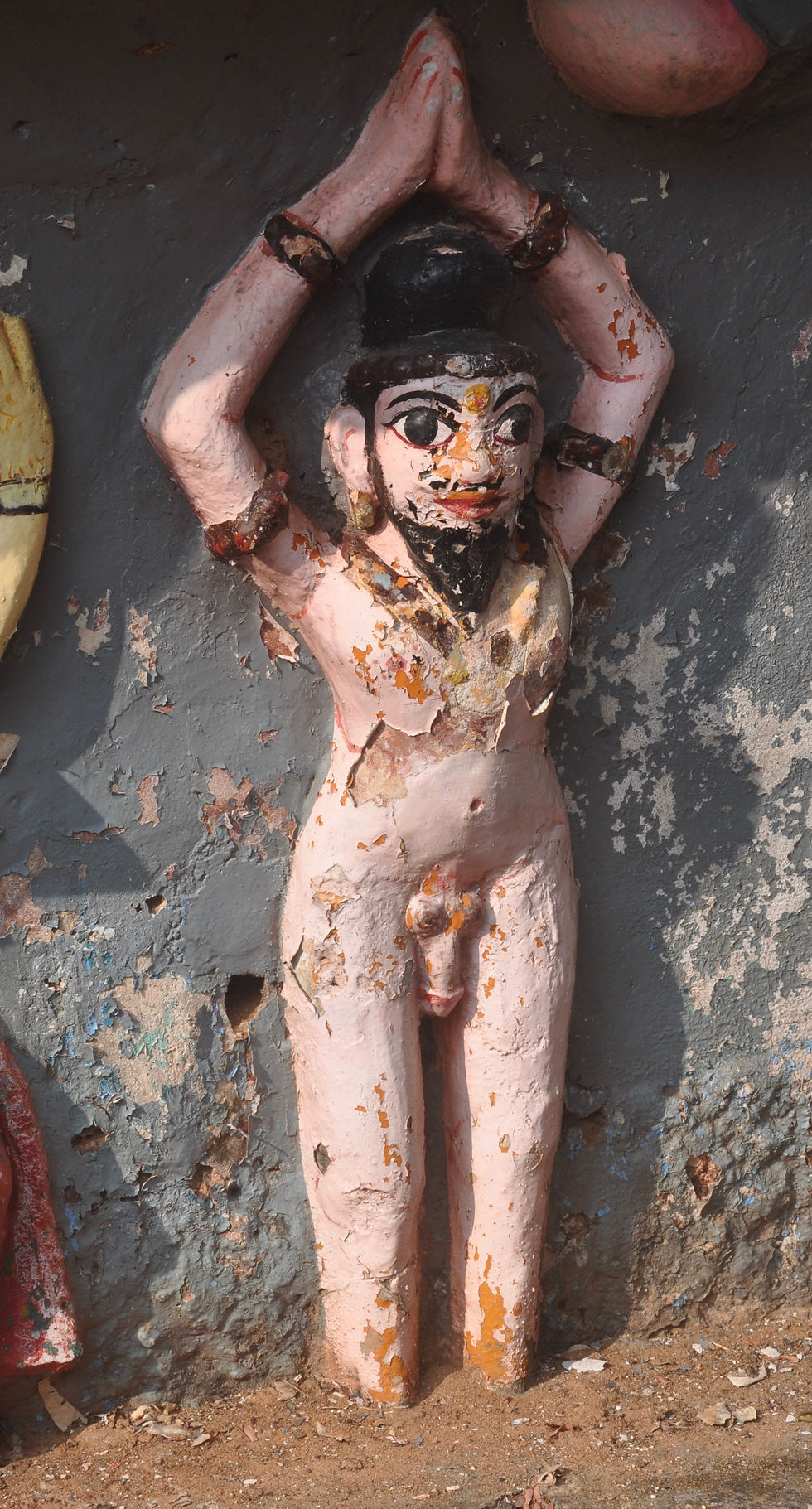
On the way to Chettinad, Bennet had a surprise for us – and, it turned out, for him too. Even in the face of Mary’s hesitation about another temple, he assured us that this one really was different. It was. We walked under a barrier, along a path bordered on each side
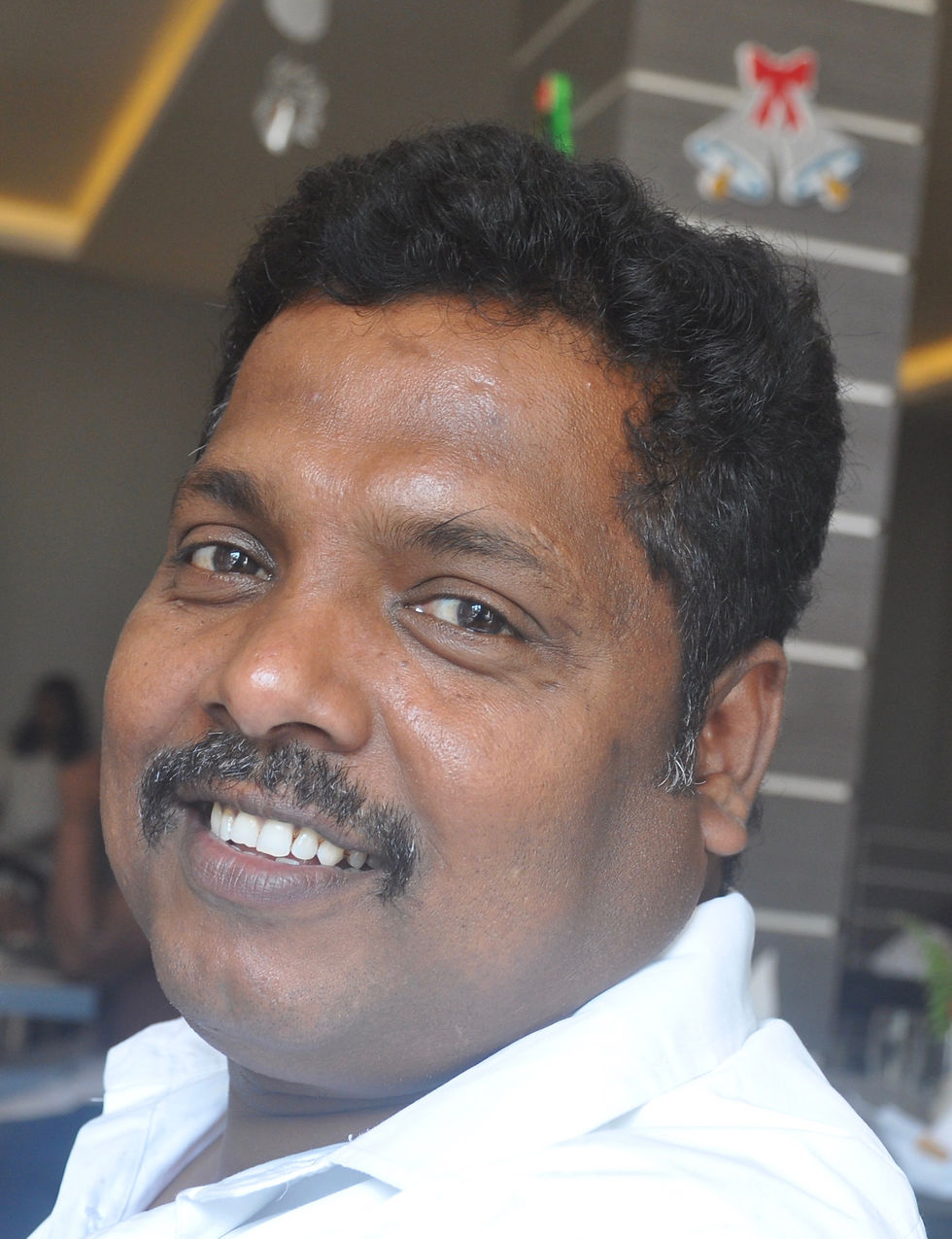
by statues of horses, all in various stages of ruin and dilapidation. Then, at the end of the path, we reached a huge tree which had fallen down, crushing whatever was under it including more horses. This was the temple. It had been an open air temple nestling under the tree. Certainly different. But now, to Bennet’s surprise, only a few sad candles and a tiny shrine survive. Apparently some weeks ago a cyclone had hit the area.
Wednesday 26 December
Our hotel in Chettinad was another wonderful CGH-run establishment, Visalam, in the village of Kannadukathan.
This is in the heart of Chettinad country. The Chettins settled there many centuries ago and did well. (My sister-in-law Shirani had explained to us before we came that some of her forebears – even though she comes from Sri Lanka – were from the area, which gave it all an added interest.) In British times, the Chettins prospered mightily as bankers to our ancestors, building themselves great mansions. One such, built in the 1930s, was our hotel, Visalam.
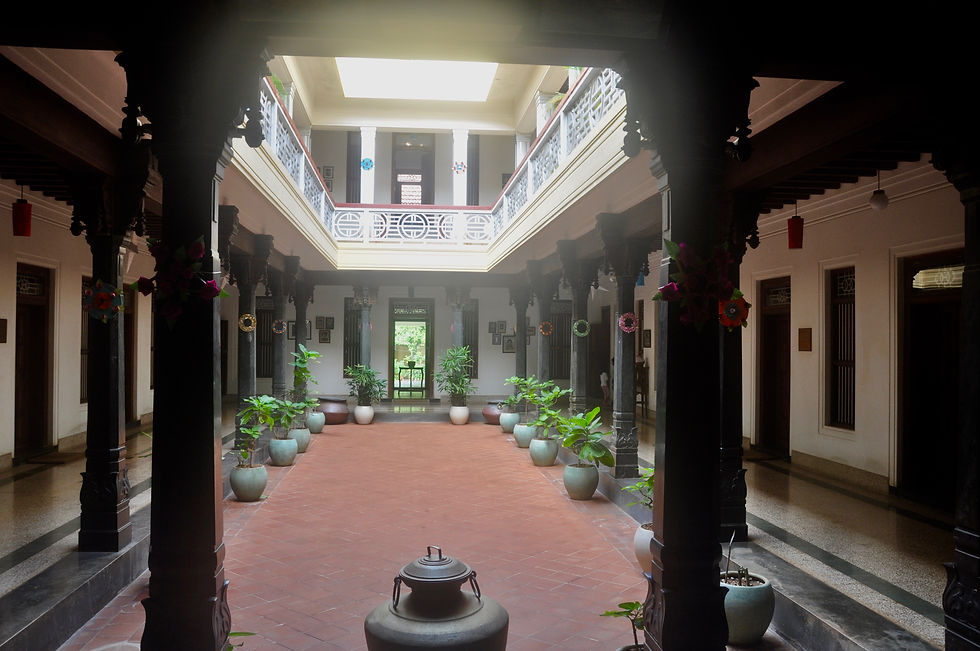
Visalam was given by its founding owner as a wedding present to his daughter. One of his granddaughters still owns it.
The idea was to see some of the mansions, which we did, but first – another temple. This temple, Vijayalaya Cholisvaram, is about 10 km outside the village and is unusual in allowing non-Hindus to enter the inner sanctum and even participate in the rituals. They are also relatively relaxed about photography inside. However, this changed recently. Some wicked person put a video of the rituals on Facebook or some such evil medium. Now, no photography in the inner sanctum. Quite right, actually.
We were led in by helpful and welcoming locals, having been equipped with a bunch of herbs to give to the god. We went in single file past the large statue (in black granite) of the recumbent god Vishnu; tried our best to admire the very lively (but black) relief statues at the back of the shrine; gave our herbs to the priest; were given some of them back and had some holy water poured into our hands; and finally were blessed by having a metal cap placed over our heads.
We were greatly helped in all this by a young man who turned out to have been on the staff of one of our recent hotels. He was there with his wife and six-month old child, all on a brand new motorbike.

Then on to the mansions. They mingle in the memory. We saw three: Lakshmi House; CVTC House; and VVRM House (Mary opting out for the latter two).
Two common features stand out. The first is the overall design which is well-adapted to the climate. The house consists of rooms constructed off a colonnaded, rectangular atrium – similar to the way the ancient Romans designed their villas. The atrium is open to the sky, subject only to metal netting to keep out birds and monkeys.
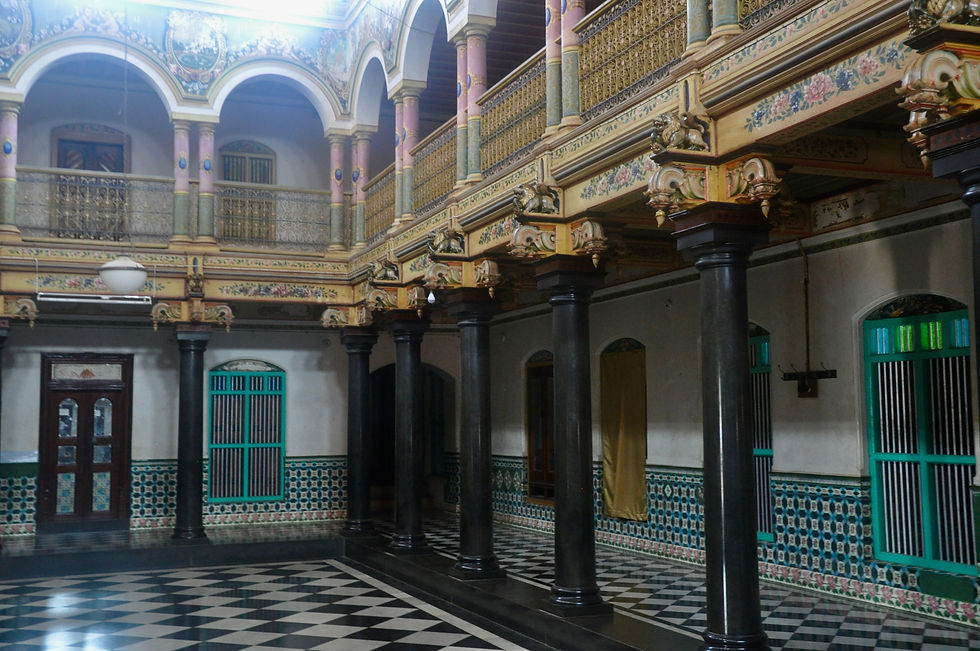
The second feature is the immaculate and intricate carving, particularly over the doorways, normally in wood but sometimes in gilded metal.

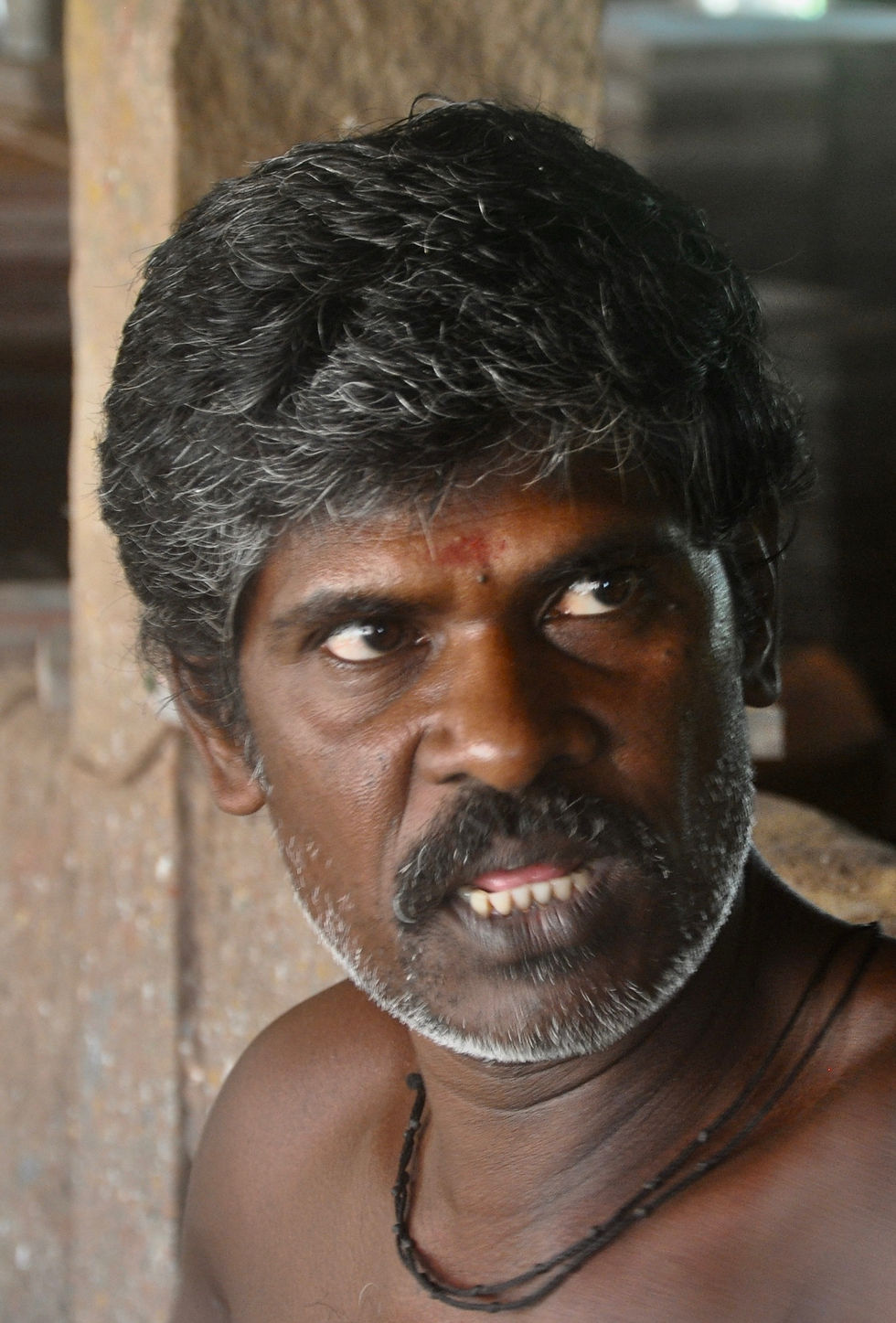
We were also taken to a tile making operation. You see them mixing the cement and chemical constituents of the tile. A highly skilled man sits on the ground, takes a metal form, fills it, and then applies paint in what seems a haphazard fashion. He then lifts it up, turns it over, and shows the most precisely defined and intricate pattern. This has to dry out for about 10 days. He makes one tile (each quite different) every few minutes.
I had been expecting to see local tiles in the mansions, but they seemed to have been imported from Portugal, Italy, even Japan.
In one of the mansions we met an elderly lady who was part of the owning family. It became
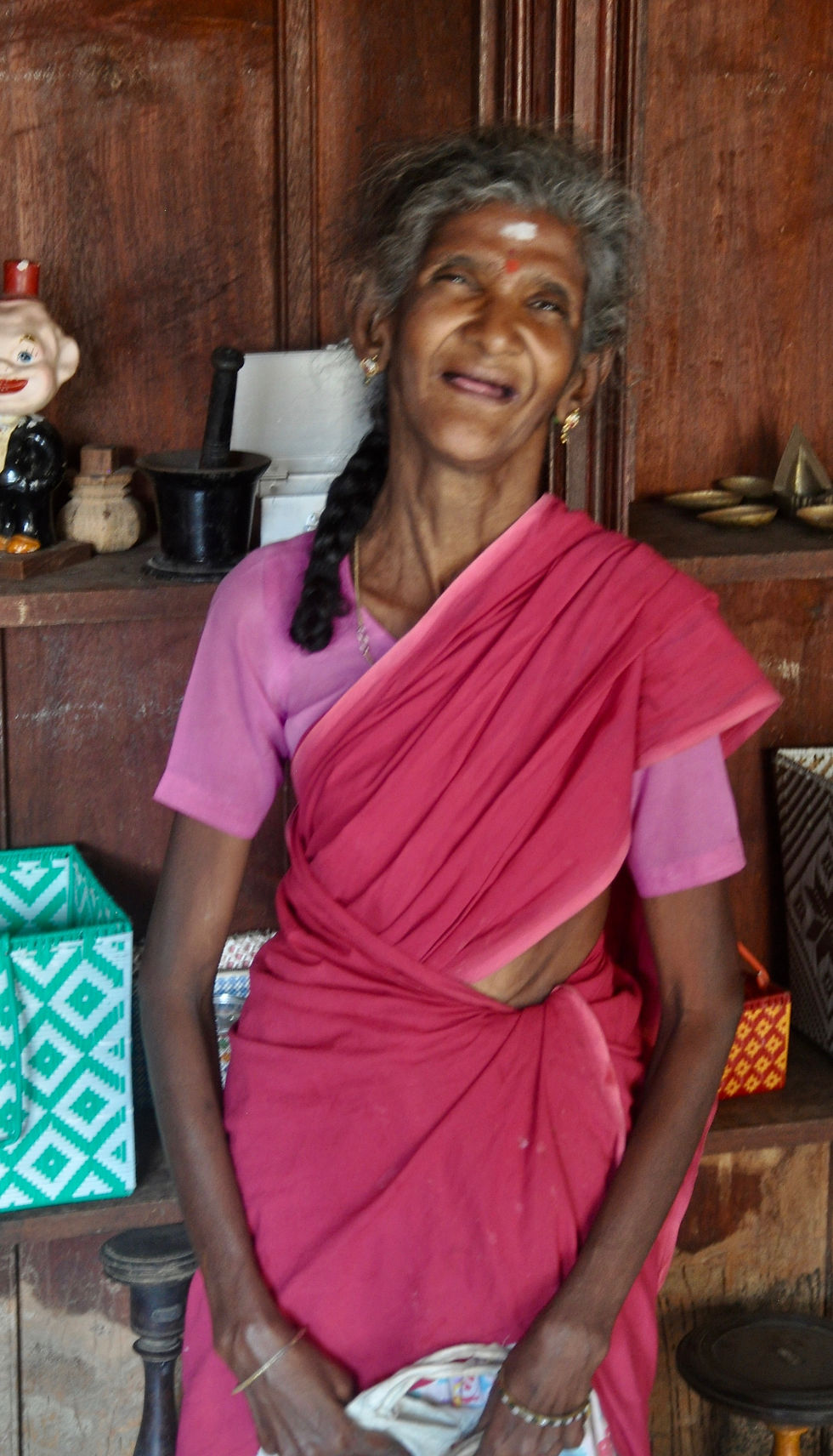
clear that she wanted to receive a tip. I was very happy to pay the 100 rupees (£1) that was expected – even if a little surprised.
Traffic conventions in India always provide food for reflection. Most trucks and tuktuks have two messages printed on the back: “Keep Left”, which is odd as you should overtake on the right; “Sound Horn”, which is much observed, both before and while you overtake. Speed limits are largely ignored and, Bennet says, unenforced. Traffic calming is sometimes done by having two barricades, one half way across the road on the left, the other half way across, 20 yards further on, on the right. Bennet has perfected a kind of slalom to overcome these obstacles.
Our strategy of chatting to carefully selected fellow guests paid off at Visalam by one of those coincidences that strain the imagination. A Tamil couple, he Yogi (even Yogi Bear!) from India, she Nemi from Malaysia. Where did they live? In Fulham on the opposite side from us of the Wandsworth Bridge Road.
Thursday 27 December
We now go to the second stage of our travels – leaving Tamil Nadu for Karnatika. First, the old capital, Mysore. Then the National Park at Nagarhole to see some wild life.
This involved a flight from Trichy some 60km away and a horrendous drive to the airport there. We had to leave at 5.00am, in the dark with bad visibility (swirling mist), exacerbated by the headlights of on-coming trucks and buses. We survived. Bennet dealt with the horrors manfully. We had to say our sad farewells to him at the airport. Then a pleasant one hour flight to Bangalore by the airline IndiGo (very good), captained by a South African.
At Bangalore we were met by our new driver, Govin, who was to be our constant companion and, to some extent guide, over the next few days. Oh dear! A charming man, but his English was minimal. We soon had to stop asking him questions, which he plainly couldn’t understand, or having any sort of conversation with him.
Bangalore, as everyone knows, is the thriving, rapidly expanding, booming centre of IT business in India. This certainly shows in the way it looks from the outside. The drive from the airport (itself ultra modern) is along a stunningly beautiful, well-maintained road flanked by palm trees and floral displays. We only skirted round the outskirts, but there the downside of the rapid expansion showed all too clearly. It took us over an hour to get away. They are building above the road what looks like the longest elevated metro line in the world. You can imagine the consequences in terms of traffic.
After 4 ½ hours driving, on reasonable roads after we had got away from Bangalore, although much traffic, we got to Gitanjali, the delightful home-stay outside Mysore that was to be our home for the next few days.
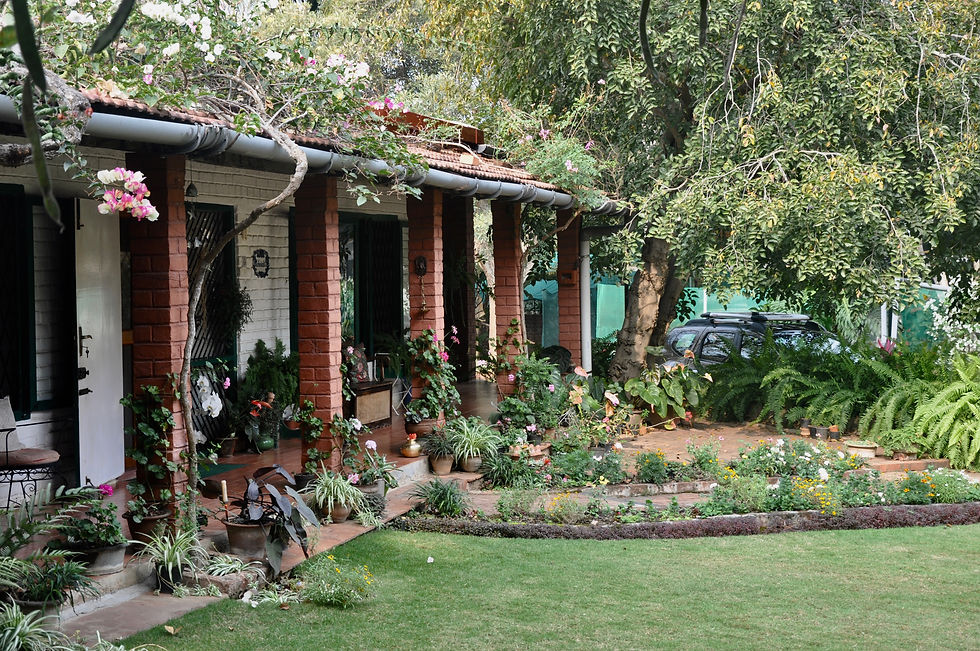
Gitanjali is a complete delight, an oasis of calm and friendliness. It consists of a small collection of bungalows, simple, not luxurious, but beautifully maintained, all in a well-watered garden. It is run by Yumana, the lovely, highly competent charming lady whose family own and live in the place. A real home-stay.
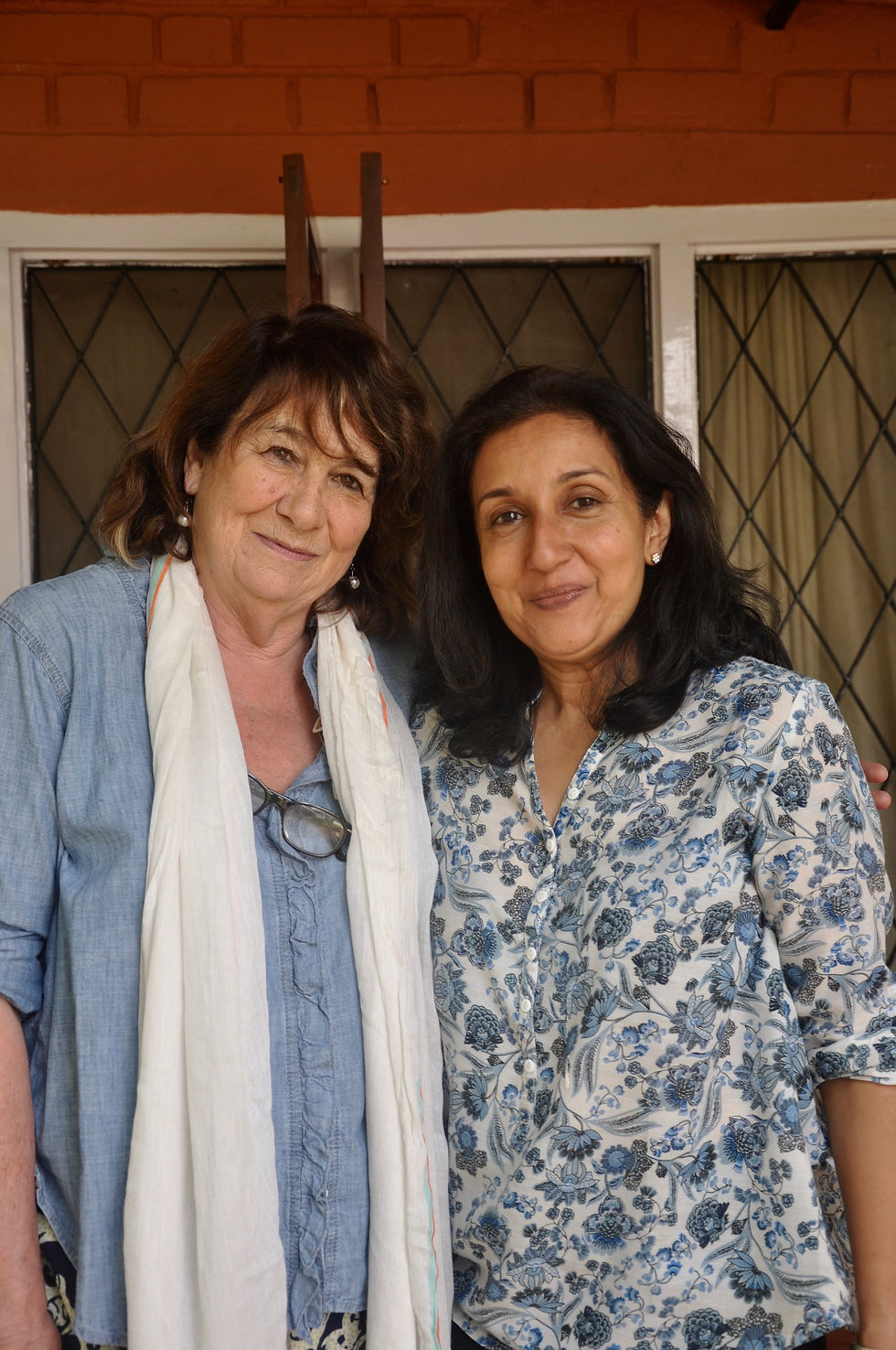
Who better than Yumana (left, with Mary) to talk to about the driver issue? She immediately got on the phone to Daniel in Trivandrum, who she seemed to know well, and very soon reported back. No problem. A new driver with good English, plus a guide, also with good English, would be with us the next day. When should they show up?
Gitanjali only takes a few guests at a time, so we had no difficulty pursuing our strategy of making new friends. Actually it would be hard not to, as we all sit round Yumana’s table for dinner. We met Shiraz from Bangalore and his Tamil wife Saveetha with their daughter, coming for just one night so that the daughter could see one of her friends. They both spoke English as a first language. And also two Englishmen: one an engineer who had studied at Gonville and Caius, Cambridge, and then worked at what seemed to be the successor of the firm in Cambridge that Alexander Gosling was involved in founding in the 1960s. So it turned out. He is married to a Tamil living in Bangalore. The other Englishman was a cost clerk (doing the billing) for a law firm in the Midlands.
(Should I apologise for recording these details about people my readers don’t know and who we ourselves may well never see again? I hope it gives some idea of the sort of people who tend to travel in these parts.)
Friday 28 December
We met our new driver and our guide at the appointed hour. Relief all round. The driver, Kumar, spoke good English. His boss, it turned out, was the linguistically challenged Govin. The guide was Roopesh, also fluent English, immensely knowledgeable, with the vital skill of being able to explain things clearly and lucidly. He was only booked for one day, but I said that we’d be happy to have him for the next day too – at extra cost. This was referred back to higher authority (Daniel, presumably) and it was all agreed – at no extra cost. Many thanks, Companion Holidays.
The main excitement of the day was the Mysore Palace. But Mysore itself is spectacular: wide tree-lined streets, orderly traffic, and clean, with many large and imposing buildings in apparently good repair, looking like palaces but turning out to be government buildings, universities, hospitals, police head quarters, whatever. In fact I’ve never seen such a splendiferous police HQ in my life.
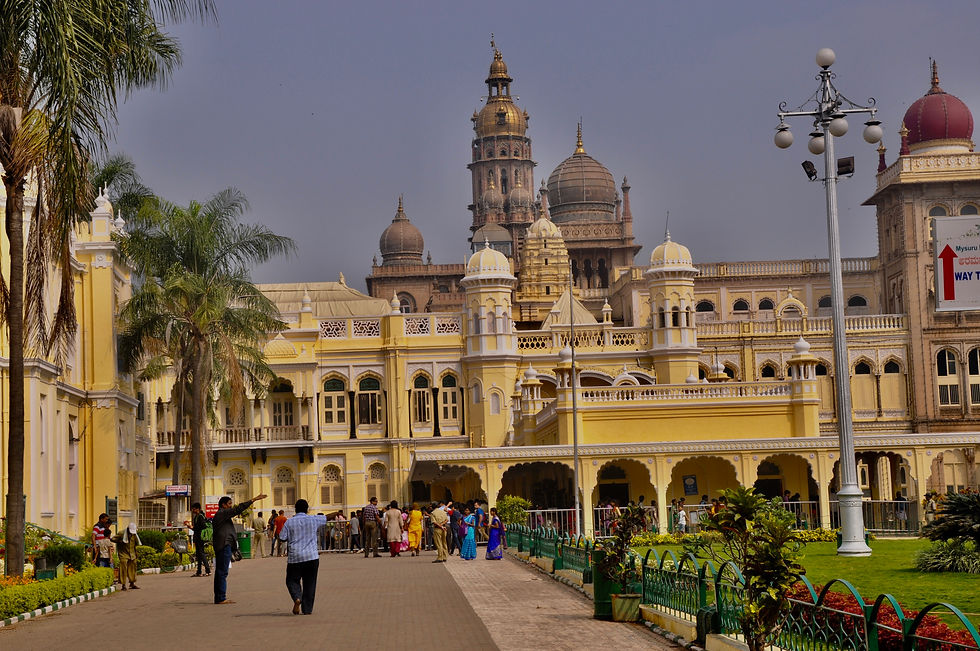
The palace is fantastic; in Indo-Saracenic style, built on the grandest scale for the ruling princely family, the Wodeyars, who held sway in Mysore for many centuries, including during the British times. Since independence they’ve lost their power, but the surviving 26-year old scion of the family still lives in part of the palace.
The palace is by no means ancient. Its predecessor was wooden and in 1897 it burnt down – a wedding party got out of hand, as they do. The then Maharaja built the present palace on the site and got the English architect Henry Irwin to design it. It was completed by 1912.
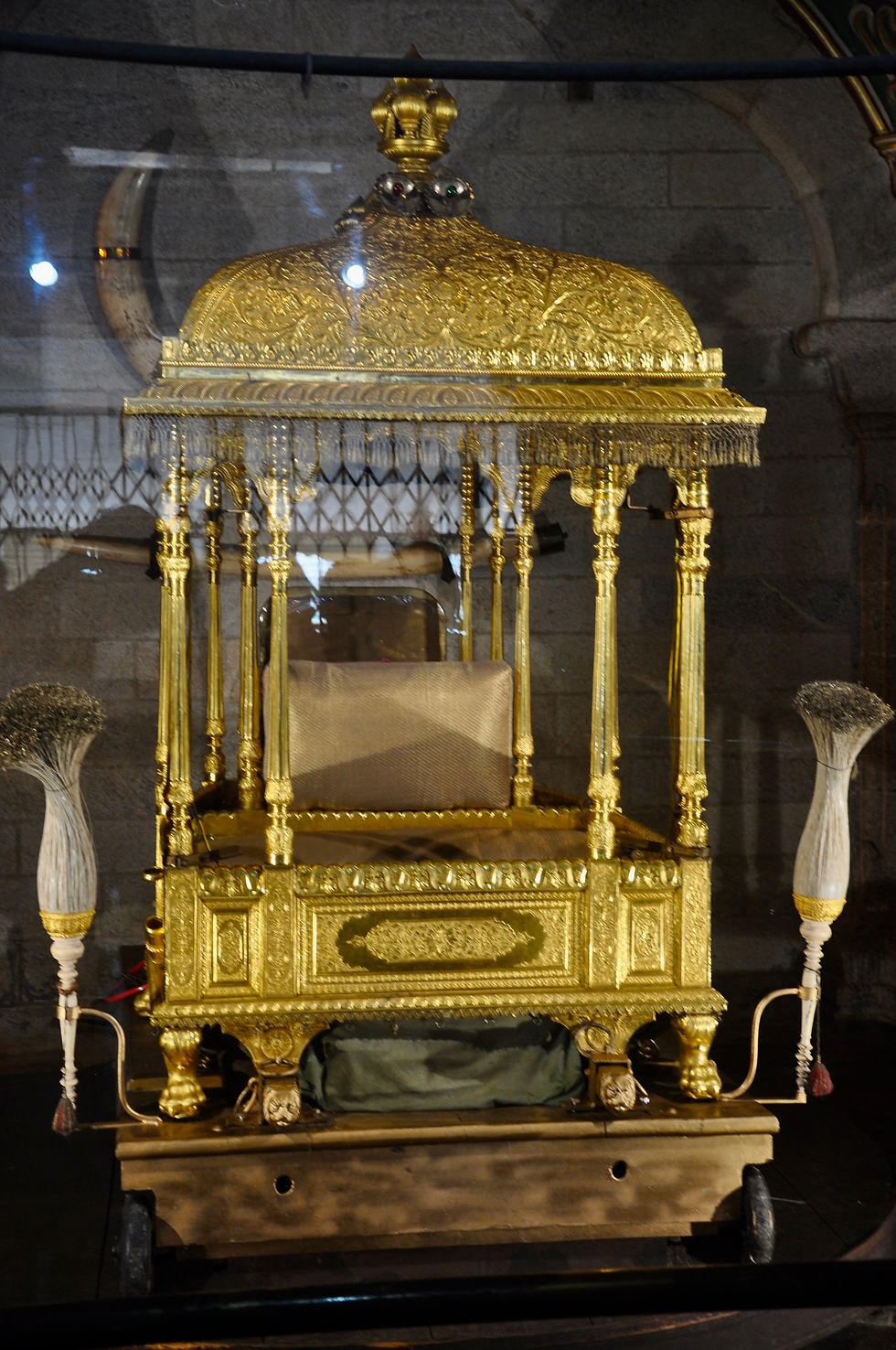
For all the details, see the guide books! But one of the exhibits that sticks in the mind is the massive gold howdah (left) in which the maharaja sat as he processed on an unfortunate elephant, as depicted in many of the murals in the palace.
We were warned about crowds, particularly as it was school holiday time. There were indeed hordes of largely well-behaved school groups (even during the holiday?). Much pushing, but all manageable. Maybe it helps being a head taller than most of the adults.
We then went to the amazing Devaraja flower and vegetable market. It’s hard to imagine a bigger, more colourful, varied market, all (again) clean and well-ordered – in contrast to many similar markets one could think of.
Finally, a drive up the Chamundi Hill that overlooks the city, with a temple at the top. We

managed to get up to the sacred bull, the Nandi, carved out of a single rock. It was also the second largest in the universe – we are seeing a lot of second biggest bulls. But we failed to reach the summit – defeated by the crowds driving up the hill in a very slow-moving queue of buses. Had we tried, we’d still be there.
A historical note. The family of Wodeyar have been Maharajas of Mysore since about 1400 AD, except for a brief interlude of less than 50 years at the end of the 18th century when the Muslims, Hyder Ali and then his son, Tipu Sultan, took over. They allied themselves with the French, which turned out to be a strategic error – even though understandable as it was when Napoleon was riding high. Tipu was defeated by the British under Lord Wellesley, the elder brother of Arthur, before the latter became Duke of Wellington. Tipu was killed at the battle of Srirangapatnam (a few miles from Mysore) in 1799. Our ancestors caused the Wodeyars to take back their throne as Maharajas and maintained good relations with them and their princely state until independence. We visit Srirangapatnam tomorrow.
Saturday 29 December
We drove the 10 miles to Srirangapatnam and met our guide Roopesh who actually lives there.
The high point is the Summer Palace of Tipu Sultan. The outside is nothing: one storey, the walls covered with green blinds to protect it from the sun. It’s worth protecting.
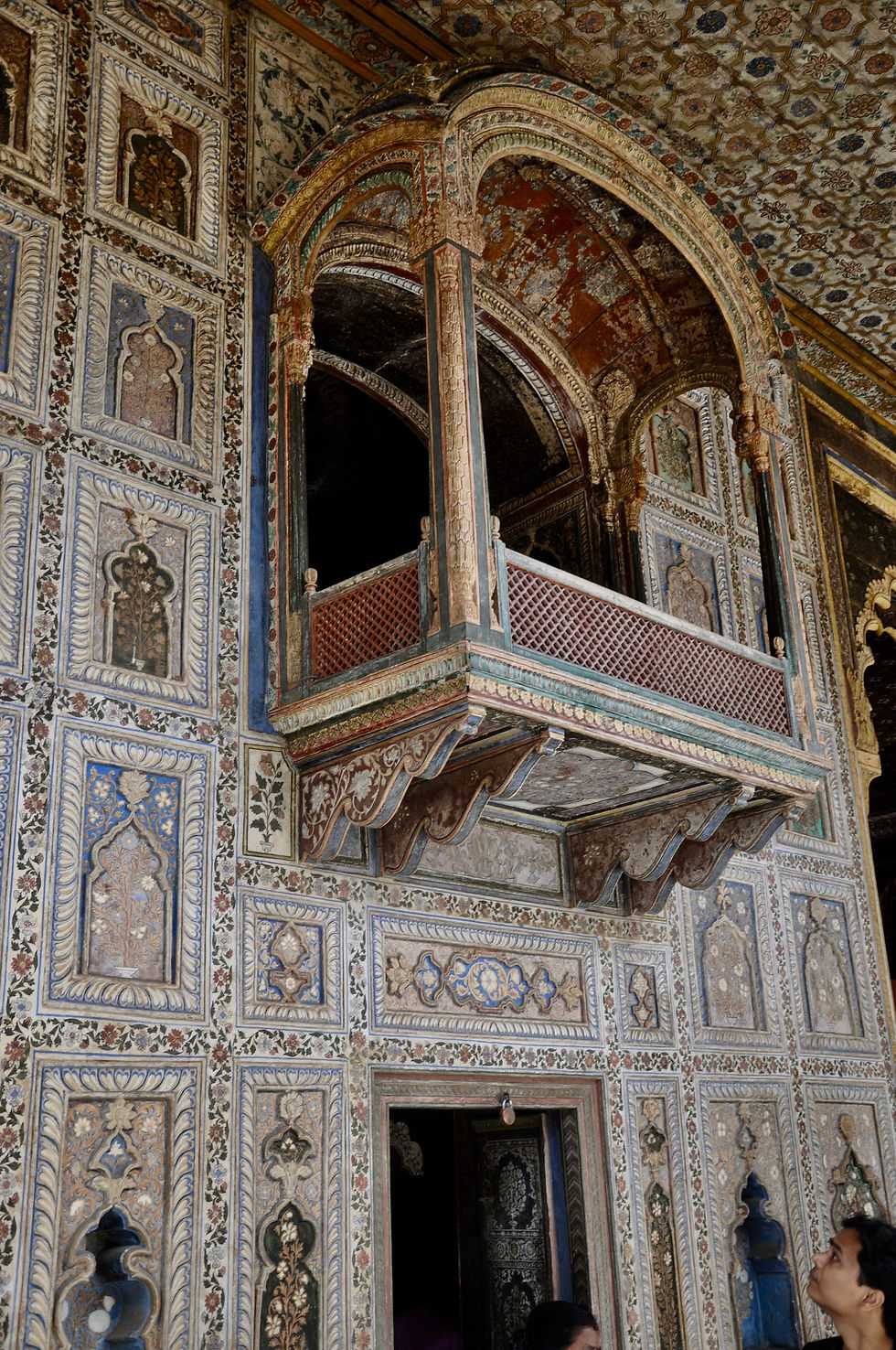
Built towards the end of the 18th century, the interior is stunning, the walls covered with the most intricate murals depicting (hélas!) the victories of Tipu and his father Hyder Ali, aided by the French, against the British in the Second Anglo-Mysore War. There are some striking portraits of Tipu and his cohorts by Thomas Hickey, an Irish painter who lived in Mysore (no relation, I think, of the more famous William Hickey).
Long lines of children in smart uniforms were being led around. Very happy to be photographed by an eccentric foreigner. Our guide doubted whether they had any idea what they were looking at. Just a nice day out.
We saw the mosque, beautifully maintained, containing the tombs of Tipu and his father and mother.
Then the fortress, or rather the three concentric walls of it, through which the British got access in the siege that ended the Anglo-Mysore Wars and ended in the death of Tipu in 1799. You also see the dungean in which British officers were incarcerated following the earlier wars which we lost.
There is a Hindu temple, the lower parts having been built in granite back in the 9th century, but the upper parts by the Muslim Tipu, doubtless to appease his Hindu subjects.
After lunch we went to the Lalitha Mahal Palace, now a government-run hotel, built in fine extravagant European style in the 1930s. Both the guide book and Kumar said how dilapidated it was. It must have had a refit: immaculate gleaming white exterior, amazing internal public rooms.
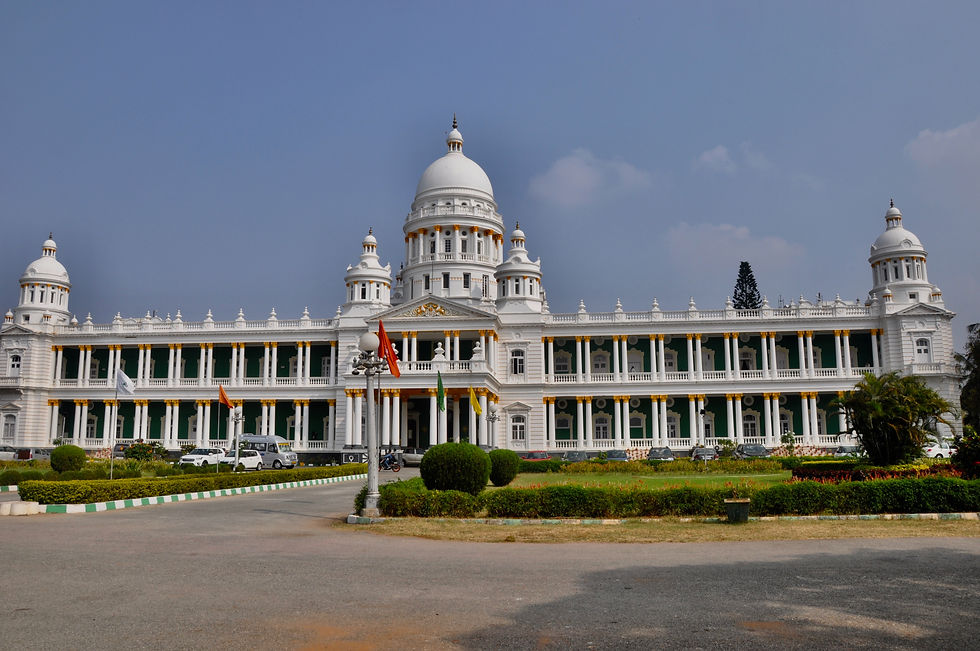
We seem to be beset by the medical problems of our guides. This time poor Roopesh had to bail out after escorting us round the Summer Palace as his father had been taken into hospital. He was replaced by Babu who we didn’t have much chance to get to know.
Before dinner but after dark, Kumar took me to see the lights. On a few days of the year, and this was one of them (because it’s Christmas!) they light up the Mysore Palace. Not just your bog-standard floodlighting, but lighting by 97,000 light bulbs (Kumar had counted them), rather like what Harrods does, if they will forgive me, on a much smaller scale. It was amazing, the whole thing accompanied by a massive flower show and witnessed by hordes of happy tourists, mostly busy taking selfies.
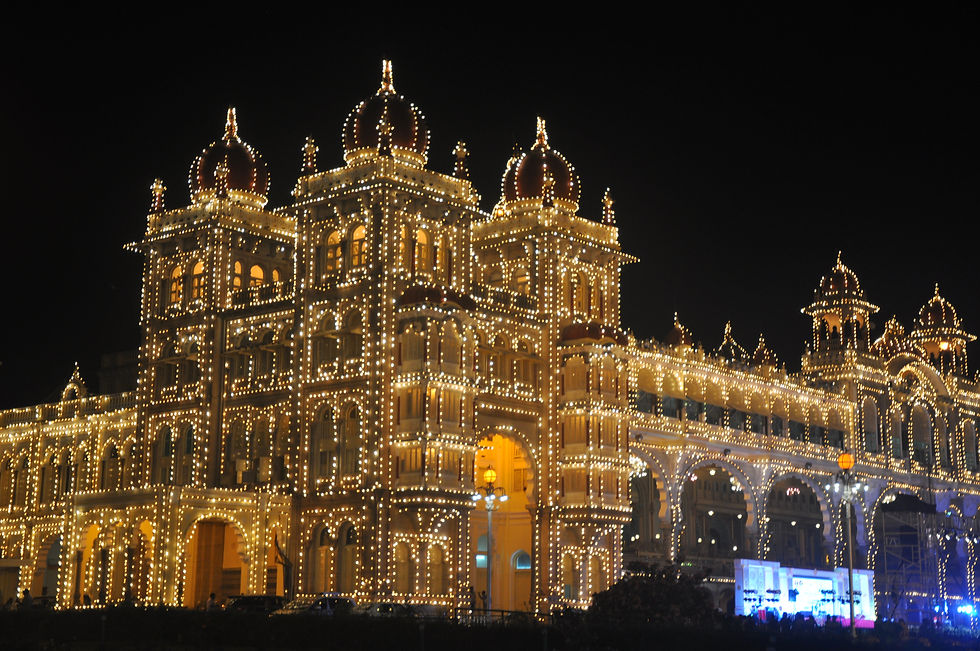
In the evening, our previous friends having moved on, we met a couple from Manley outside Sydney, Australia. He, Craig, was a photographer; she, Fiona, a graphic designer. Both charming and fun. We also met Yumana’s husband, an immaculately attired, rather serious, even slightly austere man who has had an active business career in London and elsewhere but now seems to manage the plantations they own.
Sunday 30 December
Now for a complete change – the Nagahole National Park and the resort with the curious name, Evolve Back.
But first, getting there. It’s a two-hour drive from Mysore. It started fine, but the last bit was a challenge: unmade-up roads, potholes galore, plus the usual hazards of bikes, bullock carts, goats, cows and people. Mary already had a tummy bug and I am not at my best on bumpy swervy roads, so we arrived in need of support. At Evolve Back on the banks of the Kabini River, you certainly get it. What a place!
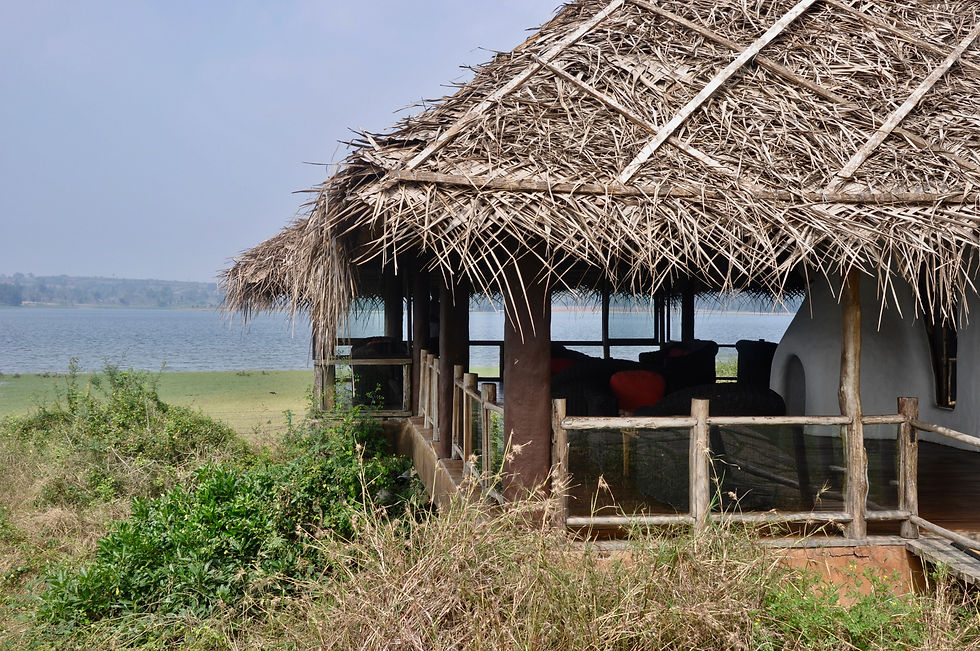
It consists of about 30 separate cabins. Ours had its own sitting room, terrace overlooking the river, tiny plunge pool; and was furnished and decorated with tasteful, very eco-friendly, wooden furniture. Quantities of staff, maybe slightly too many, endlessly asking if they can get you something. I began to feel the need for a little sign saying “How kind, but no thanks, not at the moment”.
I asked why “Evolve Back”. It originally had the name “Orange County” along with a sister resort in the Coorg district some way away. This was thought confusing, particularly as there aren’t any oranges around. So they decided on a name change to indicate their Back to Nature ideals. I reported this to Kumar who didn’t buy it at all. Oh no, it was all about GST (VAT to us). They had to change the name to get a new VAT account. Sounds like an easy fix for a VAT problem.
We had a gala dinner on our first evening, with a group of dancers from Mysore doing highly skilled traditional dances.
Monday 31 December
The first safari involved a 5.30am kick-off (Mary opted out). You clamber onto a small boat, still in pitch darkness, and cross over to the other side of the river where the National Park actually is. Then, on to big buses or, for the lucky ones jeeps. Mary had made a fuss about our not getting a jeep, which meant that I got very special treatment by being put in the front seat.
We drove for a few miles without seeing much – but were lucky later on.
Our guide (“Call me Shaun as its easier “) had told us the possible menu: deer, elephant, 300 species of bird, and of course, the stars of the piece, leopards and tigers. It is called a tiger reserve and there are almost 100 in the park, but you rarely see them. Ditto with the leopards. But we were lucky.
There was a clutch of vehicles ahead of us and the word was that there was a major predator in the bushes. Indeed, monkeys were making a serious racket, as they do when danger threatens. Apparently earlier someone had spotted a black panther, so we had to wait patiently – in silence. And then, quite unexpectedly, we saw a huge tigress strolling nonchalantly along before it disappeared into the bushes to keep the monkeys company.

We stuck around to see if the panther, or a leopard, would emerge. It didn’t. Shaun said that it would have gone for cover in the face of a tiger pacing up and down.
After that, we were a bit blasé. But we saw many deer (spotted and one big Sambar), several Langhur monkeys, wild boar, a mongoose, a serpent eagle (so named because it eats snakes) and many birds. No elephants – there are many in the park, but you are only likely to see them in the summer.
In the afternoon we went on a boat safari. This was basically about birds, although the lake created by the fairly recently constructed Kabini Dam is beautiful in the soft afternoon sunshine. Mary confessed to Shaun that birds weren’t really her thing and she found herself wondering if it was all worth while watching for another egret. But actually we saw many species, the most exciting being the painted stork (well-named) with its red legs, orange beak and other colours spread over its physique.
There was the constant refrain, particularly as the sun set, that there was always the possibility of a tiger emerging from the bushes to have a quick drink. I have to record that no tiger was thirsty.
For New Year’s Eve there was yet another gala dinner – unfortunately. No local dancers, but games – games aimed, not wholly successfully, at children. The Master of Ceremonies (or rather Mistress, if that is the correct feminine) worked hard, but had some difficulty getting shy teenagers to participate. We soon made our excuses, as they say, and left – allowing 2019 to arrive uncelebrated by us. We did however identify some like-minded potential friends in the shape of a French couple, and agreed to have dinner with them the following day.
New Year’s Day
I went on another early morning safari. I hope it’s not an omen for 2019. Certainly no tigers, but also not much else, despite the energetic Shaun following up on endless cries emanating from the jungle, indicating, so he told us, that a leopard was moving around. But nothing emerged. Not even monkeys, although there were plenty of deer.
In the evening we had our planned dinner with the French couple. Typically, he turned out to be a lawyer who knew and had worked with all the lawyers I knew in Paris. He now does arbitration work and, of course, knows Bill Rowley, one of the big beasts of the arbitration world. He, Philippe, and his wife, Marie-Pierre, are charming with a good sense of humour. I hope we stay in touch.

A final note about Evolve Back. A lovely place. Superb service. It has been going for about 10 years, with about 170 staff and only 30 rooms. The stars for us (left) were the naturalist and guide Shaun and the tall, elegant cook, waitress, manager (she seemed to do all these things) Akshar. It turned out that they are engaged.
Wednesday 2 January
We were driven back to Mysore by the redoubtable Kumar, who had had two days respite from us, staying, he told us, free of charge, in an adjacent lodging. The drive seemed much better on the way back; not quite sure why.
We were deposited at the Metropole Hotel in Mysore, which is something of a landmark. It’s an old-style palatial edifice built in the 1920s by the then Maharaja to accommodate his “British guests”. We find ourselves allotted the Maharaja Suite, a room the size of an apartment with a large colonnaded terrace overlooking the garden. The Maharaja’s guests must have been very happy. It was built, surprisingly, by the engineering firm, Dorman Long, when they weren’t doing the Sydney Harbour Bridge and other major engineering feats. Photographs of Sir Arthur Dorman and Sir Albert Long on the staircase (no lifts) made one feel quite at home.

Thursday 3 January
The final excitement of the trip was a train journey from Mysore to Bangalore.
The general westerner’s perception of travel by train has been that it is fraught with all sorts of hazard in the form of seething crowds, unintelligible directions, squalid loos and, probably, delays. Hence you book first class and go for the express services. Which is what Jane had done for us. Kumar took us to the station and pointed us in a general sort of way to the platforms.
We had no need to worry. Mysore station is clean and well-run, with clear announcements. Our train was the Bangalore/Chennai express and there it was, some 45 minutes before departure, having its windows cleaned. We had numbered seats in the first class carriage. Very comfortable, air-conditioned splendour. I walked through some of the other carriages to see how they were doing. Very little difference: also comfortable, also air-conditioned. All in all, a delightful experience.
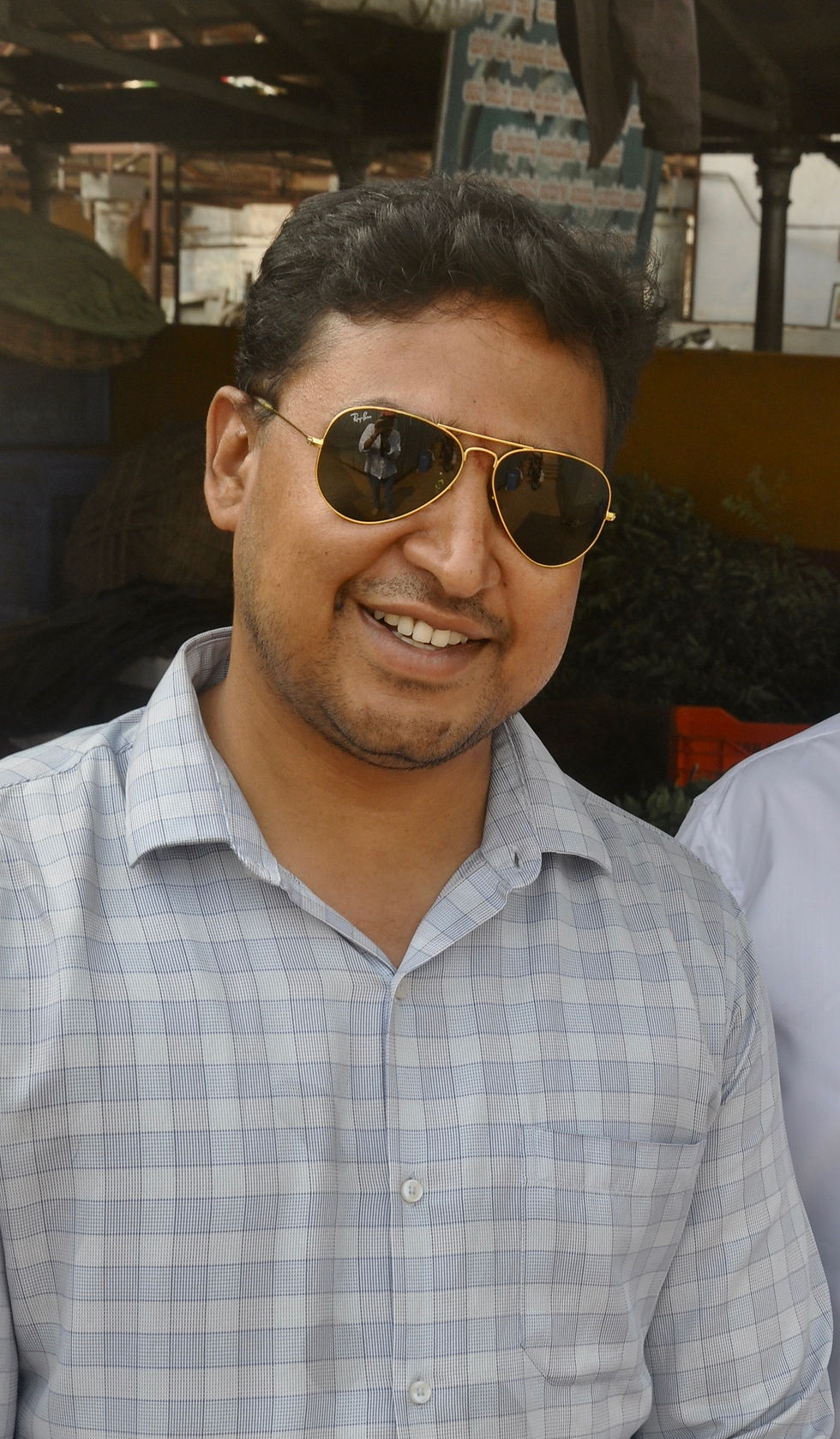
We were met at the other end by the faithful Kumar, who had driven with our luggage. He took us to the Taj airport hotel where we said our goodbyes to him.
The Taj, as you would expect, is a model of modernity and efficiency, although posing the usual challenges in these places when it comes to working out how to switch the lights on and off.
Ditto the spanking new international airport. It provides, as you go through the immigration desks, a new, very up-to-date, euphemism: we are not just Senior Citizens and certainly not Disabled, we are “Differently Abled”.
Tony Herbert
7 January 2019

Comments